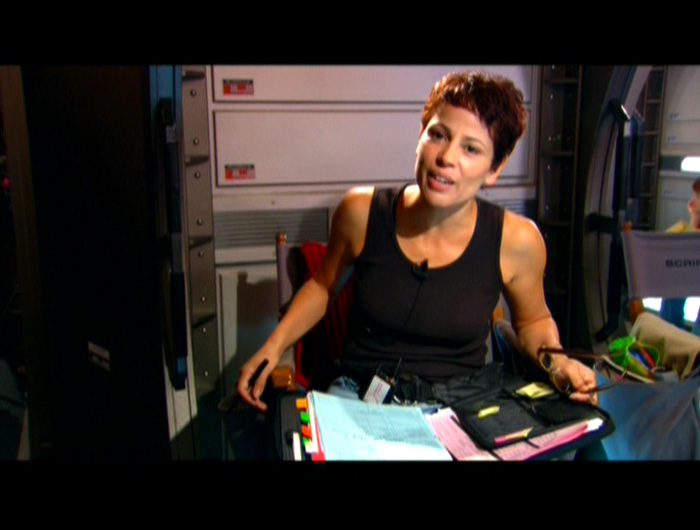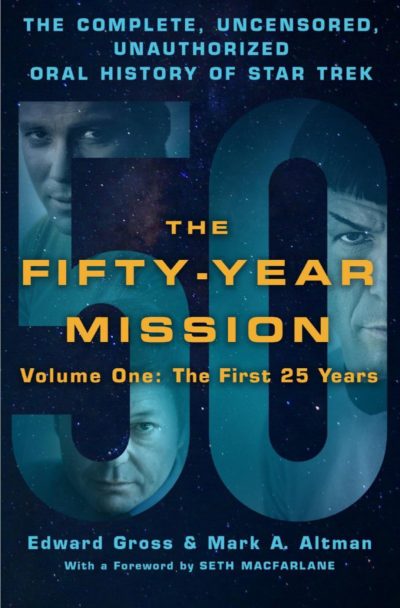Dear Gene,
– excerpts from a letter from Margaret M. Bailey (Chatham Township, NJ), dated September 30, 1975, printed in Susan Sackett’s Letters to Star Trek (1977).
I would like to mention several aspects of Star Trek which I hope you will consider changing in the script(s) you are preparing. Each of these aspects contributes to a view of the women of the future in a way I believe is unsupportable and irresponsible.
…It would not be socially responsible to perpetuate such unparallel treatment of the sexes in a portrayal of the future which we hope to be less discriminatory and concerned primarily with each individual’s best contribution to the combined welfare of humanity.
The costumes and make-up of women on Star Trek episodes are not realistic. Even today women generally wear clothes applicable to their jobs. To suppose that they will wear dresses, let alone skirts so shirt that their crotches are but inches from view, is silly…the costumes in the episode “Where No Man Has Gone Before” were reasonable and dignified for both sexes. Why not use them for future scripts?
The depiction of women in the scripts is rather distasteful too. They are consistently shown in soft lights, sexy hairdos, and in scenes guaranteed to draw attention to their physical attractiveness for the men of the crew and in the audience. Again, why only the women?…
…Finally, the language used to refer to the women and men. Why the use of “girl” but not “boy” to refer to crew members? And “yeoman” for a female? How about “Where No MAN Has Gone Before?”…
…The most effective means I can suggest to help you understand how such treatment of women comes across is to try to imagine it all in reverse. For example:
Male yeoman has collapsed on the bridge. Captain (a woman, of course) orders the doctor (a woman) to “take the boy to sickbay.” Boy enters the bridge. Close up, soft lights, romantic music, emphasis on the tight, sexy costume. Captain sighs, looks at the doctor, who winks at her. Boy is specialist in geophysics. Captain wonders what he’d be like in bed…Landing party is in trouble. The lone male member looks pleadingly at the Captain. “I’m frightened,” he says.
It’s not very pleasant to see one’s sex portrayed as weaker and less reliable, always relying on the other sex, which is strong, dependable and always professional.
Despite its sexist flaws in the original series, there are many feminists who are fans and who ignore or curse those flaws now. They are not prepared to do so with future scripts. We look forward to an improved Star Trek, one which we can look relate to and not feel alienated by.
In the book, Roddenberry offers his thoughts on the subject of the above letter, about a decade after TOS first aired see below. His response starts out ok but then gets a bit defensive. Parts remind me of how J.J. Abrams defended the Into Darkness Alice Eve bra scene, by arguing it was ok because Kirk had his shirt off in a scene and there was almost a Benedict Cumberbatch shower scene.
Yes, by today’s standards, indeed [TOS] was [male chauvinistic]. We didn’t use women as strongly as we might have. We did have women lieutenants, women attorneys. We often fell into the trap of making the captain’s secretary-valet (the yeoman) a woman. I think if we did begin today we would start off more advanced than we were able to at the time.
Gene Roddenberry tells Susan Sackett what he thinks about the above letter, in 1975.
In my speeches, in my appearances around the country, I think that women’s liberation is probably the question that comes up most often, and inquiries related to it are some of the most angry and critical I get. We’re apt to get very angry, challenging questions, such as ‘Isn’t it true that you used women as sex symbols? You could see it in their costumes.’
Yes, that is true. It came out of many things. It came out of the fact that I do see women as sex symbols. But the only defense that I can offer is that in my younger years I was also seen by women as a sex symbol. I think that is part of the lovely fabric and the game of life. And I see nothing wrong with it.
I think Bill Shatner with his shirt off in a show was very much a sex symbol to the females in the audience. I think there’s nothing wrong with using women as sex symbols as well, as long as that’s not the only way you’re using women…
Also, we can’t ignore the fact that I was playing to a 1964-1966 audience with a large group that would enjoy seeing women in a setting not too different from what was the norm then and would be pulled close to the show by seeing those things.
Would I change that? I think not a great deal, although we talked about having more women around and giving them better assignments, but would I change those sexual things? No, I think they’re great fun…
Also, you cannot produce a television show using continuing male actors without having some pressure from them to be playing opposite lovely, sensual, sexual women. There is a continual pressure from the actors: ‘Hey, let me win the girl now.’ And they get a charge out of playing a character who is so masculine, aggressive and charming and so on that he wins the girl. It’s an ego trip, but that’s not a very bad thing…
I was also playing to people who were unsympathetic toward the Women’s Liberation Movement, or who are made to feel uncomfortable by it, so I couldn’t have women’s liberation there at every moment in every scene. Remember, Star Trek was in a mass medium playing to a mass audience and I couldn’t give more than a fair amount of time to any one view point.”
It’s also interesting because there’s an argument out there in fandom that it’s not fair to critique sexism in TOS because “it was the ’60s.” Regardless of my argument that it is fair to consider both context and impact, since TOS still airs and influences culture heavily today this letter shows there were fans at the time raising issues too.









